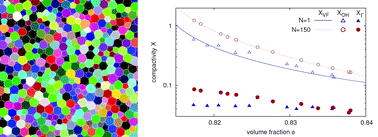Measuring the configurational temperature of a binary disc packing
Abstract
Jammed packings of granular materials differ from systems normally described by statistical mechanics in that they are athermal. In recent years a statistical mechanics of static granular media has emerged where the thermodynamic temperature is replaced by a configurational temperature X which describes how the number of mechanically stable configurations depends on the volume. Four different methods have been suggested to measure X. Three of them are computed from properties of the Voronoi volume distribution, the fourth takes into account the contact number and the global volume fraction. This paper answers two questions using experimental binary disc packings: first we test if the four methods to measure compactivity provide identical results when applied to the same dataset. We find that only two of the methods agree quantitatively. This implies that at least two of the four methods are wrong. Secondly, we test if X is indeed an intensive variable; this becomes true only for samples larger than roughly 200 particles. This result is shown to be due to recently measured correlations between the particle volumes [Zhao et al., Europhys. Lett., 2012, 97, 34004].


 Please wait while we load your content...
Please wait while we load your content...